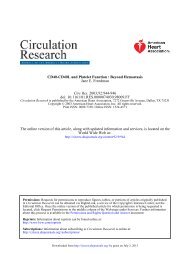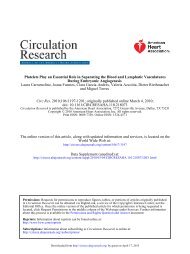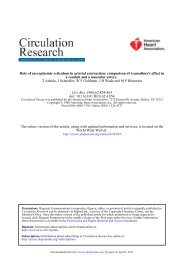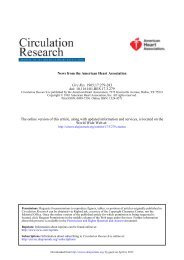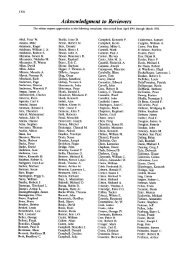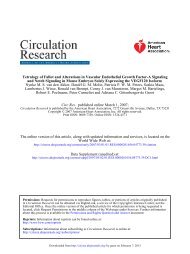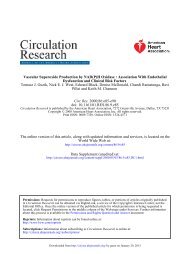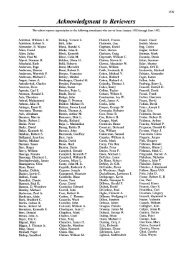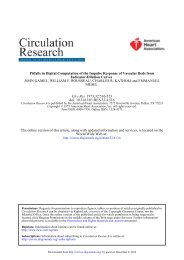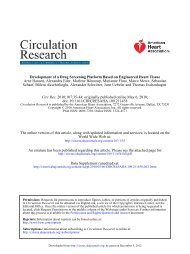RICHARD V. EBERT, CRAIG W. BORDEN, WENDELL H. HALL and ...
RICHARD V. EBERT, CRAIG W. BORDEN, WENDELL H. HALL and ...
RICHARD V. EBERT, CRAIG W. BORDEN, WENDELL H. HALL and ...
You also want an ePaper? Increase the reach of your titles
YUMPU automatically turns print PDFs into web optimized ePapers that Google loves.
A Study of Hypotension (Shock) Produced by Meningococcus Toxin<br />
<strong>RICHARD</strong> V. <strong>EBERT</strong>, <strong>CRAIG</strong> W. <strong>BORDEN</strong>, <strong>WENDELL</strong> H. <strong>HALL</strong> <strong>and</strong> DAVID GOLD<br />
Circ Res. 1955;3:378-384<br />
doi: 10.1161/01.RES.3.4.378<br />
Circulation Research is published by the American Heart Association, 7272 Greenville Avenue, Dallas, TX 75231<br />
Copyright © 1955 American Heart Association, Inc. All rights reserved.<br />
Print ISSN: 0009-7330. Online ISSN: 1524-4571<br />
The online version of this article, along with updated information <strong>and</strong> services, is located on the<br />
World Wide Web at:<br />
http://circres.ahajournals.org/content/3/4/378<br />
Permissions: Requests for permissions to reproduce figures, tables, or portions of articles originally published in<br />
Circulation Research can be obtained via RightsLink, a service of the Copyright Clearance Center, not the<br />
Editorial Office. Once the online version of the published article for which permission is being requested is<br />
located, click Request Permissions in the middle column of the Web page under Services. Further information<br />
about this process is available in the Permissions <strong>and</strong> Rights Question <strong>and</strong> Answer document.<br />
Reprints: Information about reprints can be found online at:<br />
http://www.lww.com/reprints<br />
Subscriptions: Information about subscribing to Circulation Research is online at:<br />
http://circres.ahajournals.org//subscriptions/<br />
Downloaded from<br />
http://circres.ahajournals.org/ by guest on November 28, 2012
A Study of Hypotension ^Shock) Produced by<br />
Meningococcus Toxin<br />
By <strong>RICHARD</strong> V. <strong>EBERT</strong>, M.D., <strong>CRAIG</strong> W. <strong>BORDEN</strong>, M.D., <strong>WENDELL</strong> H. <strong>HALL</strong>, M.D. AND<br />
DAVID GOLD, M.D.<br />
Hemoclynamic alterations were produced in dogs by injecting meningococcus toxin. Hypotension<br />
<strong>and</strong> u decrease in cardiac output occurred without significant reduction in blood volume. These<br />
changes were accentuated by small hemorrhage. Increasing the blood volume above normal led to<br />
marked increase in cardiac output with slight increase in arterial pressure. The arterial pressure was<br />
markedly increased by the administration of levarterenol but large doses were required. Cortisone<br />
did not modify the effect of meningococcus toxin on the circulation. Meningococcus toxin apparently<br />
produced its effect by increasing the volume of blood in small blood vessels.<br />
A ACUTE<br />
circulatory disturbance<br />
characterized by hypotension <strong>and</strong>,<br />
at times, by a clinical picture resembling<br />
traumatic shock is observed in<br />
patients with serious acute infections. It is<br />
most frequently seen in association with<br />
bacteremia. A number of instances of the<br />
syndrome have been observed following the<br />
accidental introduction of large numbers of<br />
bacteria into the blood stream through the<br />
administration of contaminated blood. 121<br />
The circulatory failure associated with<br />
acute infection appears to differ from traumatic<br />
shock in that it is not initiated by a diminution<br />
in blood volume.' 4 Relatively little is known of<br />
the hemodynamics of this type of circulatory<br />
failure because of the difficulty in studying<br />
these extremely ill patients.<br />
A knowledge of the effect of bacteria on the<br />
circulation of the experimental animal should<br />
aid in the underst<strong>and</strong>ing of this problem.<br />
Relatively few studies of this type are available.<br />
It was found that severe hypotension<br />
could be produced in the dog by the intravenous<br />
injection of meningococcus toxin. A study of<br />
the hemodynamics of this circulatory disturbance<br />
was carried out.<br />
METHODS<br />
Mongrel clogs weighing from 6 to 12 Kg. were<br />
used. Local anesthesia was used in all experiments.<br />
From the Variety Club Heart Hospital, Minneapolis,<br />
the Surgical Research Laboratory, Ancker<br />
HoHpital, St. Paul, <strong>and</strong> the Department of Medicine<br />
of the University of Minnesota.<br />
Received for publication April 4, 1955.<br />
378<br />
General anesthesia was avoided because of lack of<br />
knowledge of the influence of anesthesia on the effect<br />
of the bacterial toxin. The measurements prior to<br />
administration of toxin may have been modified by<br />
the restlessness of the animals. After production of<br />
circulatory failure by the toxin the animals were<br />
stuporous or comatose.<br />
The cardiac output was measured by the dye<br />
method of Moore <strong>and</strong> associates. 6 Plasma volume<br />
was measured by the T-1S24 dye method. 1 Pressures<br />
in various portions of the circulatory system <strong>and</strong> the<br />
intrapleural pressure were measured by the use of a<br />
strain gauge <strong>and</strong> direct writing Sanborn Poly-Viso.<br />
Arterial mean pressure was measured in the carotid<br />
artery. Right atrial, pulmonary arterial <strong>and</strong> left<br />
atrial pressures were measured by st<strong>and</strong>ard catheterization<br />
procedures.<br />
Meningococcus toxin was prepared by a modification<br />
of the method of Thomas <strong>and</strong> Good. 7 Adequate<br />
potency of the toxin was assured by inoculating<br />
eight large slants of Mueller-Hinton agar medium<br />
with meningococci. After 24 hours at 37 C. the<br />
growth was harvested with a small amount of 0.S5<br />
per cent saline. The suspension was inoculated into<br />
a Kolle flask containing Mueller-Hinton agar medium<br />
with 0.7 per cent glucose. Incubation was<br />
then carried out at 37 C. for4S hours in 10 per cent<br />
carbon dioxide. The growth was harvested with 10<br />
ml. of 0.85 per cent saline. The suspension was centrifugal<br />
at 4000 R.P.M. for 45 minutes. The supernatant<br />
fluid was aspirated <strong>and</strong> tested for sterility.<br />
This material was used for the experimental studies.<br />
The toxin was stored at 10 C. <strong>and</strong> used within 4S<br />
hours.<br />
The undiluted toxin was injected intravenously<br />
or into the right atrium. The amount used varied<br />
from 0.4 to 2.0 ml. per Kg. Most animals received<br />
1 ml. per Kg. A large inoculum of meningococci was<br />
of critical importance. Results of preliminary tests<br />
of the toxin in rabbits often failed to agree with the<br />
results in dogs.<br />
At the conclusion of the experiment the dogs were<br />
Downloaded from<br />
http://circres.ahajournals.org/ by guest on November 28, 2012<br />
Circulation Reirard, Vriume III, Jtili IBSi
examined at autopsy. Small visceral hemorrhages<br />
were noted in most instances. The most frequent<br />
location was in the endocardium <strong>and</strong> lungs. The adrenals<br />
exhibited small, never massive, hemorrhages<br />
in about one-half of the animals studied.<br />
RESULTS<br />
Following intravenous injection of meningococcus<br />
toxin into the dogs there was a gradual<br />
fall in arterial pressure. The maximum decline<br />
in pressure usually occurred 45 minutes to<br />
one hour after injection. The animals became<br />
stuporous. Vomiting <strong>and</strong> diarrhea were often<br />
present. The effect of early lots of toxin was<br />
variable in spite of efforts to insure a uniform<br />
preparation. Certain lots produced little effect<br />
on the arterial pressure whereas other lots<br />
in identical volumes produced severe hypotension.<br />
In evaluating the effect of the toxin on the<br />
arterial pressure, cardiac output, blood volume<br />
<strong>and</strong> right atrial pressure, it was arbitrarily<br />
decided to select for analysis the results in 15<br />
animals in which the arterial pressure fell<br />
below 80 mm. Hg.<br />
The results given in Table 1 show that the<br />
decline of mean arterial pressure found in<br />
every experiment was accompanied by a<br />
reduction in cardiac output in all except two<br />
instances (dogs 3, 6). Since the heart rate<br />
Dog<br />
1<br />
2<br />
3<br />
4<br />
6<br />
7<br />
9<br />
10<br />
12<br />
13<br />
14<br />
15<br />
16<br />
20<br />
22<br />
Weight<br />
9.5<br />
6.4<br />
7.7<br />
7.0<br />
9.5<br />
10.0<br />
8.6<br />
S.4<br />
9.1<br />
10.9<br />
12.7<br />
12.7<br />
9.1<br />
17.0<br />
S.2<br />
Mean<br />
Arterial<br />
Pressure<br />
mm. Hg<br />
Before<br />
176<br />
182<br />
124<br />
156<br />
130<br />
145<br />
124<br />
130<br />
128<br />
143<br />
136<br />
117<br />
117<br />
133<br />
143<br />
After<br />
76<br />
73<br />
78<br />
53<br />
74<br />
64<br />
63<br />
42<br />
75<br />
55<br />
52<br />
65<br />
55<br />
78<br />
78<br />
<strong>EBERT</strong>, <strong>BORDEN</strong>, <strong>HALL</strong> AND GOLD 379<br />
TABLE 1.—Effect of Meningococcus Toxin on the Circulation<br />
Cardiac Output<br />
L./Kg./mm.<br />
Before<br />
.143<br />
.190<br />
.176<br />
.306<br />
.248<br />
.206<br />
.326<br />
.274<br />
.238<br />
.226<br />
.12S<br />
.145<br />
.147<br />
.164<br />
.204<br />
After<br />
.116<br />
.128<br />
.187<br />
.144<br />
.315<br />
.077<br />
.107<br />
.063<br />
.105<br />
.080<br />
.035<br />
.057<br />
.045<br />
.094<br />
.128<br />
Total Peripheral<br />
Resistance<br />
dynes/seconds/<br />
cm "*<br />
Before<br />
10270<br />
11921<br />
72S6<br />
5794<br />
4409<br />
5621<br />
3530<br />
4502<br />
4715<br />
4649<br />
6673<br />
5062<br />
0980<br />
9244<br />
6846<br />
After<br />
5461<br />
7113<br />
4329<br />
41%<br />
1971<br />
6647<br />
5475<br />
6287<br />
6260<br />
504S<br />
9231<br />
7113<br />
10723<br />
9444<br />
5874<br />
Right Atrial<br />
Pressure<br />
mm. Hg<br />
Before<br />
0<br />
-0.5<br />
-2.6<br />
0<br />
+0.5<br />
+2.0<br />
+2.6<br />
-1.3<br />
0<br />
+0.6<br />
—<br />
+ 1.6<br />
-0.6<br />
-1.9<br />
-1.0<br />
increased in all but two animals, the stroke<br />
volumes were obviously reduced. Since right<br />
atrial pressure in all but two animals, <strong>and</strong><br />
effective right atrial pressure measured in five<br />
dogs, decreased, the reductions in cardiac<br />
output <strong>and</strong> stroke volumes were obviously<br />
associated with reduction in venous return,<br />
as is the case in oligemic shock. This deduction<br />
is confirmed by the reduction of pulmonary<br />
arterial pressure measured in ten animals <strong>and</strong><br />
of left atrial pressure recorded in eight animals.<br />
The data on plasma volume <strong>and</strong> hematocrit<br />
readings indicate that total blood volume<br />
calculated therefrom increased in eight <strong>and</strong><br />
decreased slightly in seven experiments, but the<br />
variations were not significant. In other words,<br />
the acute reduction in mean arterial pressure<br />
appears to be caused by acute reduction of<br />
cardiac output without reduction in blood<br />
volume.<br />
Calculations of total peripheral resistance<br />
(T.P.R.) presented in table 1 show a definite<br />
reduction in four experiments (dogs 1, 2, 3, G),<br />
a significant increase in seven (dogs 7, 9, 10,<br />
12, 14, 15, 16), <strong>and</strong> doubtfully directed changes<br />
in the four remaining dogs. While induction of<br />
peripheral arteriolar dilation may thus have<br />
contributed to the hypotension in a few animals,<br />
it was certainly not the main causative<br />
After<br />
-0.2<br />
-1.5<br />
-1.3<br />
-2.0<br />
-2.5<br />
-0.5<br />
-2.6<br />
-0.2<br />
0<br />
-2.6<br />
—<br />
-0.6<br />
-4.0<br />
-2.1<br />
-3.8<br />
Left Atrial<br />
Pressure<br />
mm. Hg<br />
Before<br />
—<br />
—<br />
—<br />
—<br />
+ 11.0<br />
+5.2<br />
—<br />
+ 1.6<br />
+5.2<br />
+5.1<br />
—<br />
+5.S<br />
+5.3<br />
—<br />
After<br />
—<br />
—<br />
—<br />
—<br />
+S.0<br />
+2.6<br />
—<br />
0<br />
0<br />
+4.3<br />
—<br />
+2.2<br />
+3.1<br />
—<br />
Mean<br />
Pulmonary<br />
Artery<br />
Pressure<br />
mm. Hg<br />
Before<br />
17<br />
13<br />
22<br />
12<br />
19<br />
15<br />
17<br />
—<br />
13<br />
17<br />
17<br />
—<br />
—<br />
—<br />
—<br />
After<br />
15<br />
9<br />
13<br />
11<br />
13<br />
10<br />
13<br />
—<br />
7<br />
S<br />
14<br />
—<br />
—<br />
—<br />
—<br />
Plasma<br />
Volume<br />
ml.<br />
Before<br />
379<br />
301<br />
545<br />
353<br />
507<br />
521<br />
540<br />
3SS<br />
459<br />
469<br />
460<br />
3S0<br />
—<br />
460<br />
—<br />
Downloaded from<br />
http://circres.ahajournals.org/ by guest on November 28, 2012<br />
After<br />
426<br />
414<br />
563<br />
467<br />
459<br />
459<br />
602<br />
438<br />
529<br />
420<br />
360<br />
360<br />
—<br />
500<br />
—<br />
Hematocrit<br />
Reading<br />
Before<br />
47.0<br />
46.7<br />
19.2<br />
47.0<br />
39.0<br />
54.5<br />
41.0<br />
42.8<br />
50.5<br />
4S.4<br />
47.0<br />
49.0<br />
56.0<br />
50.0<br />
53.0<br />
After<br />
4S.0<br />
40.3<br />
16.3<br />
42.3<br />
39.2<br />
59.0<br />
3S.0<br />
42.8<br />
52.0<br />
49. S<br />
55.0<br />
48.0<br />
62.0<br />
4S.5<br />
59.0
380 SHOCK DUE TO BACTERIAL TOXIN<br />
TABLE 2.—Effect of Hemonhage (10 ml. per Kg.) on<br />
Hypotension Produced by Meningococciis Toxin<br />
DOE<br />
5<br />
6<br />
S<br />
12<br />
Cardiac Output<br />
L./Kg./Min.<br />
Before<br />
.716<br />
.315<br />
.134<br />
.105<br />
After<br />
.060<br />
.077<br />
.065<br />
.071<br />
Total Periphera<br />
Mean Arterial Resistance<br />
Pressure mm. Hg dynes/seconds/<br />
cm." 1<br />
Before<br />
97<br />
74<br />
S6<br />
75<br />
After<br />
56<br />
55<br />
4S<br />
50<br />
Before<br />
7594<br />
1971<br />
4916<br />
6260<br />
After<br />
S623<br />
5957<br />
5658<br />
6595<br />
.factor for the hypotension induced by the<br />
toxin.<br />
The effect of reduction of blood volume on<br />
the hypotension produced by toxin was<br />
studied. Four animals were given toxin intravenously.<br />
After the maximum decline in<br />
arterial pressure had occurred, blood in the<br />
amount of one per cent of the body weight<br />
was removed. The observations were repeated<br />
ten minutes later (table 2). The further decline<br />
in arterial pressure was principally associated<br />
with a marked further reduction in cardiac<br />
output in all four animals consequent to<br />
further impairment of venous return by the<br />
hemorrhage. Calculation of the T.P.R., which<br />
showed a marked increase in one experiment<br />
(dog 6), <strong>and</strong> probably insignificant increases<br />
in the three others, supports this contention.<br />
A hemorrhage of this magnitude in the normal<br />
animal would have relatively little permanent<br />
•effect on cardiac output <strong>and</strong> arterial pressure.<br />
Inasmuch as the hypotension <strong>and</strong> reduction<br />
in cardiac output following the administration<br />
of toxin was accompanied by a reduction in<br />
Don<br />
1<br />
2<br />
4<br />
6<br />
7<br />
10<br />
13<br />
15<br />
16<br />
22<br />
systemic <strong>and</strong> pulmonary venous pressure, an<br />
experiment was performed to determine the<br />
effect of increasing the blood volume on the<br />
circulation. Hypervolemia was produced by<br />
the intravenous infusion of 6 per cent dextran<br />
in 0.85 per cent saline. Toxin was first administered<br />
to the animals. When a maximum<br />
decline in arterial pressure had occurred,<br />
dextran solution in the amount of 30 ml. per<br />
Kg. was administered. Observations were<br />
made immediately before <strong>and</strong> after the infusion<br />
of dextran. The results on 10 animals<br />
are given in table 3. The right atrial pressure<br />
<strong>and</strong> the cardiac output increased after dextran<br />
infusion to above the control level, while the<br />
increase in arterial pressure was of a lesser<br />
degree. This was apprently due to the fact<br />
that there was a marked decline in total<br />
peripheral resistance after administration of<br />
dextran in the majority of experiments.<br />
The effect of levarterenol on the arterial<br />
pressure <strong>and</strong> cardiac output was studied in<br />
eight animals. Observations on the effect of<br />
levarterenol prior to the administration of<br />
toxin revealed that a moderate pressor response<br />
was produced by infusion at the rate of 20<br />
tig. per min. A marked pressor response was<br />
produced by infusion at the rate of 40 ^g- per<br />
min. Following administration of toxin <strong>and</strong><br />
development of hypotension, a larger quantity<br />
of levarterenol was required to produce a<br />
pressor response in some of the animals. The<br />
course of a typical experiment is shown in<br />
figure 1. The amount of levarterenol required<br />
to produce a rise in arterial pressure of 20<br />
TABLE 3.—Effect of Dextran (SO ml. per Kg.) on Hypotension Produced by Meningococciis Toxin<br />
Mean Arterial Pressure<br />
mm. Hg<br />
Before<br />
76<br />
73<br />
53<br />
74<br />
64<br />
42<br />
55<br />
65<br />
55<br />
78<br />
After<br />
129<br />
130<br />
102<br />
S2<br />
6S<br />
63<br />
125<br />
104<br />
91<br />
107<br />
Right Atr al Pressure<br />
mm Hg<br />
Before<br />
-0.2<br />
-1.5<br />
-2.0<br />
-2.5<br />
-0.5<br />
-0.2<br />
-2.6<br />
-0.6<br />
-4.0<br />
-3.S<br />
After<br />
+0.5<br />
+ 14.3<br />
+2.0<br />
+0.2<br />
0<br />
0<br />
-0.2<br />
+0.5<br />
+0.5<br />
+0.7<br />
Before<br />
.116<br />
.128<br />
.144<br />
.315<br />
.077<br />
.063<br />
.OSO<br />
.057<br />
.045<br />
.128<br />
Cardiac output<br />
L./Kg /min.<br />
After<br />
.218<br />
.410<br />
.318<br />
.274<br />
.103<br />
.200<br />
.280<br />
.322<br />
.364<br />
.305<br />
Total Peripheral Resistance<br />
dynes/ seconds/cm."*<br />
Before<br />
5475<br />
7113<br />
4196<br />
1971<br />
6647<br />
6274<br />
504S<br />
7113<br />
10723<br />
5874<br />
Downloaded from<br />
http://circres.ahajournals.org/ by guest on November 28, 2012<br />
After<br />
4955<br />
3969<br />
3650<br />
2504<br />
5275<br />
2997<br />
3290<br />
2025<br />
21S5<br />
3423
Arterial<br />
Pratsure<br />
Heart Rate<br />
per rain.<br />
Cardiac Output<br />
l./mln.<br />
tAQ<br />
iao<br />
&o<br />
too<br />
too<br />
4<br />
Atrial Pressure 4<br />
mm. Hq<br />
t -<br />
ml.<br />
Procedure<br />
Tirao minutei<br />
.1<br />
: I •<br />
||<br />
|<br />
: • t t<br />
ft'<br />
III<br />
<strong>EBERT</strong>, <strong>BORDEN</strong>, <strong>HALL</strong> AND GOLD 381<br />
I<br />
•<br />
Mil<br />
Illl<br />
. 1<br />
• •<br />
|<br />
t t to<br />
1<br />
s.<br />
s<br />
FIG. 1. Graphic representation of the course of a<br />
typical experiment (dog No. 15) showing response of<br />
the mean arterial pressure, heart rate, cardiac output,<br />
effective right atriul pressure <strong>and</strong> blood volume<br />
to injoctions of meningococcus toxin, levarterenol<br />
<strong>and</strong> doxtrun.<br />
mm. Hg or more was 20 ng. per min. in two<br />
animals, 40 jug- per min. in two animals, 80<br />
fig. per min. in two animals <strong>and</strong> 320 fig. per<br />
min. in two animals. The average increase in<br />
arterial pressure in these 8 animals was 38<br />
mm. Hg. The average increase in cardiac<br />
output was 29.5 ml./min./Kg. The cardiac<br />
output increased in six of the eight animals.<br />
The increase was statistically significant for<br />
the group (p < .02).<br />
Because of the relationship of the adrenal<br />
cortex to the integrity of the vascular system,<br />
the effect of cortisone on the response of the<br />
circulation to meningococcus toxin was studied.<br />
The animals were given cortisone acetate<br />
10 mg. per Kg. intramuscularly. One half of<br />
the total dose was given 12 hours prior to the<br />
administration of the toxin <strong>and</strong> the remainder<br />
one-half hour before injection of the toxin.<br />
Because of the variation in potency of various<br />
lots of toxin, 7 pail's of animals were studied.<br />
These received the same dose of the same lot<br />
of toxin on the same day. The results are<br />
given in table 4. The average mean arterial<br />
pressure was 184 mm. Hg in the cortisonetreated<br />
animals prior to the administration of<br />
toxin. This was significantly higher than the<br />
average pressure in the control group of 142<br />
mm. Hg (p < .05). The average cardiac<br />
output was also slightly higher in the cortisonetreated<br />
animals but this was not statistically<br />
significant. The values were .253 L. per Kg.<br />
per minute for the cortisone group <strong>and</strong> .223<br />
L. per Kg. per minute for the controls. Following<br />
administration of toxin, the arterial pressure<br />
fell in all animals <strong>and</strong> was lower in 4 of<br />
the cortisone-treated dogs than in their untreated<br />
controls (pairs 1, 4, 5, 7). Although<br />
the percentage decrease in cardiac output in<br />
the cortisone-treated dogs was less than in<br />
the untreated controls with two exceptions<br />
(pairs 1 <strong>and</strong> 4), this was not significant. The<br />
average mean arterial pressure for the cortisone-treated<br />
group of dogs after the administration<br />
of toxin was 85 mm. Hg <strong>and</strong> for the<br />
control group it was 81 mm. Hg. Corresponding<br />
average values for cardiac output were<br />
.111 L. per Kg. per minute <strong>and</strong> .103 L. per<br />
Kg. per minute respectively. It is evident that<br />
cortisone therapy did not protect the animals<br />
from the hypotensive effect of toxin. This is<br />
TABLE 4.—Effect of Previous Administration of<br />
Cortisone on Arterial Pressure <strong>and</strong> Cardiac Output<br />
Following Administration of Meningococcus Toxin.<br />
Pair 1*<br />
No cortisone<br />
Cortisone<br />
Pair 2<br />
No cortisone<br />
Cortisone<br />
Pair 3<br />
No cortisone<br />
Cortisone<br />
Pair 4<br />
No cortisone<br />
Cortisone<br />
Pair 5<br />
No cortisone<br />
Cortisone<br />
Pair 6<br />
No cortisone<br />
Cortisone<br />
Pair 7<br />
No cortisone<br />
Cortisone<br />
Mean Arterial<br />
Pressure mm. HR<br />
Before After<br />
121<br />
165<br />
133<br />
163<br />
143<br />
166<br />
143<br />
175<br />
163<br />
156<br />
146<br />
20S<br />
149<br />
234<br />
101<br />
69<br />
7S<br />
104<br />
7S<br />
106<br />
91<br />
75<br />
S5<br />
67<br />
54<br />
97<br />
S3<br />
79<br />
Cardiac Output<br />
L./Kd./min.<br />
Before<br />
.164<br />
.570<br />
.164<br />
.250<br />
.204<br />
.232<br />
.220<br />
.20S<br />
.275<br />
.133<br />
.218<br />
.265<br />
.320<br />
.125<br />
After<br />
.195<br />
.052<br />
.094<br />
.177<br />
.128<br />
.140<br />
.084<br />
.066<br />
.112<br />
.06S<br />
.062<br />
.1S3<br />
.047<br />
.094<br />
* Paired animals received the same lot of toxin<br />
<strong>and</strong> the same dose of toxin per Kg. on the same day.<br />
Downloaded from<br />
http://circres.ahajournals.org/ by guest on November 28, 2012
382 SHOCK DUE TO BACTERIAL TOXIN<br />
of interest because of the relationship of<br />
acute circulatory failure in meningococcemia<br />
in human beings to massive adrenal hemorrhage.<br />
The combination of meningococcemia,<br />
shock <strong>and</strong> adrenal hemorrhage has been<br />
called the Waterhouse-Friderichsen syndrome.<br />
It has been postulated that the circulatory<br />
failure is caused by adrenal insufficiency.<br />
This has been denied by other authors 8 who<br />
have pointed out that acute circulatory failure<br />
occurs in the absence of massive adrenal hemorrhage.<br />
In these animals massive adrenal<br />
hemorrhages were not seen. The ineffectiveness<br />
of cortisone would suggest that adrenal insufficiency<br />
was not playing an important role<br />
in the production of circulatory failure following<br />
the administration of meningococcus toxin.<br />
DISCUSSIOX<br />
The hemodynamic effects of meningococcus<br />
toxin can best be explained by an increase in<br />
volume of blood in peripheral vessels. The<br />
resulting diminution in venous return would<br />
account for the fall in right atrial <strong>and</strong> pulmonary<br />
vascular pressures <strong>and</strong> the decrease<br />
in cardiac output in the presence of a normal<br />
total blood volume. This mechanism appears<br />
to be the basic factor incuding hypotension<br />
following administration of toxin. The critical<br />
effect of changes in blood volume is also<br />
compatible with this hypothesis. Diminution<br />
in blood volume by a small hemorrhage caused<br />
further decline in cardiac output <strong>and</strong> arterial<br />
pressure. Increase of blood volume above<br />
normal by dextran infusion raised the right<br />
atrial pressure to normal or increased levels,<br />
<strong>and</strong> led to a marked increase in cardiac output.<br />
The arterial pressure also increased but to a<br />
lesser extent.<br />
Lack of conclusive directional change or<br />
actual increase of the calculated T.P.R. following<br />
administration of toxin suggests that there<br />
was little change in resistance to flow at the<br />
level of the arterioles. This is based on the<br />
assumption that the arterioles contribute the<br />
majority of the resistance reflected by the<br />
calculated T.P.R. As emphasized by Green<br />
<strong>and</strong> co-workers, 8 interpretations of changes in<br />
vascular tonus based upon calculations of<br />
T.P.R. should be made cautiously. Alterations<br />
of cell plasma ratio <strong>and</strong> of blood flow will<br />
influence the effective viscosity of the blood.<br />
Changes in intravascular pressures will produce<br />
passive changes in the size of the vessels.<br />
It appears unlikely that the contribution of<br />
these factors to the observed changes is of<br />
sufficient importance to alter the main implications<br />
of the data.<br />
The basic mechanisms bj r which meningococcus<br />
toxin produces its effect on the circulation<br />
is unknown. Two possibilities may be<br />
considered. The toxin may alter the elastic<br />
properties of small vessels permitting them to<br />
distend more completely at a given pressure.<br />
This effect could be mediated through direct<br />
damage to vascular endothelium or musculature<br />
or indirectly through humoral, metabolic,<br />
or nervous mechanisms. A second, <strong>and</strong> more<br />
remote, possibility is that the toxin has no<br />
effect on the elastic properties of small vessels<br />
but induces active venoconstriction with subsequent<br />
rise of pressure <strong>and</strong> distention of<br />
distal small vessels. In regard to the above<br />
possibilities, the following observations are of<br />
interest. Bacterial toxins have been observed<br />
to produce hemorrhage <strong>and</strong> necrosis in<br />
tumors. 10 Direct observations of the effect<br />
of the polysaccharide derived from Serralia<br />
marcescens on tumor tissue <strong>and</strong> normal muscle<br />
have been made. 11 Slowing of the arterial <strong>and</strong><br />
venous circulation with capillary stasis<br />
occurred. Meningococcus toxin as well as<br />
products from other bacteria produce the<br />
Shwartzman phenomenon. Thomas 7 has observed<br />
cortical necrosis of the kidneys of<br />
rabbits following repeated injection of<br />
meningococcus toxin. These observations suggest<br />
a profound effect of bacterial toxins on<br />
the small vessels.<br />
The effect of meningococcus toxin on the<br />
circulation is similar to the effect of the toxin<br />
of Clostridium oedematiens. In the experiments<br />
of Aub, Zamecnik <strong>and</strong> Nathanson a marked<br />
fall in arterial pressure <strong>and</strong> cardiac output<br />
followed the injection of the toxin of Clostridium<br />
oedemalien8. n There was only a slight<br />
decrease in blood volume. Increase in blood<br />
volume by transfusion with blood or albumin<br />
Downloaded from<br />
http://circres.ahajournals.org/ by guest on November 28, 2012
led to an immediate rise in arterial pressure<br />
<strong>and</strong> cardiac output. The right atrial pressure<br />
remained low. In the heart-lung preparation<br />
the toxin produced pulmonary edema, but the<br />
effect on cardiac function was minimal."<br />
The heart was capable of increased work at a<br />
time when the pulmonary circulation was<br />
greatly impaired.<br />
The hemodynamic changes produced by<br />
bacterial toxins also resemble those described<br />
in irreversible hemorrhagic shock. Following<br />
severe hemorrhage <strong>and</strong> prolonged hypotension<br />
in dogs, reinfusion of blood restores the blood<br />
volume to normal. The arterial pressure <strong>and</strong><br />
cardiac output rise initially but later decline<br />
to low levels. Wiggers H reviewed the experimental<br />
evidence on this type of shock <strong>and</strong><br />
concluded that stagnation <strong>and</strong> pooling of<br />
blood in minute vessels are dominantly concerned<br />
in reducing venous return. Fine <strong>and</strong><br />
his co-workers 16 • 16 ' 17 have recently shown that<br />
the dog in hemorrhagic shock loses its normal<br />
ability to destroy bacteria. They demonstrated<br />
that during hemorrhagic shock a bacterial<br />
factor develops in the dog's tissues <strong>and</strong> is<br />
responsible for the irreversibility to transfusion.<br />
A marked reduction in the incidence of irreversible<br />
shock was achieved by treatment of<br />
the dogs with antibiotics prior to hemorrhage,<br />
provided the bacterial flora of the animals<br />
had not become resistant to the antibiotic<br />
used.<br />
SUMMARY AND CONCLUSIONS<br />
Meningococcus toxin was administered to<br />
unanesthetized dogs. Hypotension <strong>and</strong> a decrease<br />
in cardiac output were produced. The<br />
blood volume did not decrease significantly.<br />
Right <strong>and</strong> left atrial pressures <strong>and</strong> pulmonary<br />
arterial pressure decreased.<br />
A small hemorrhage following administration<br />
of toxin produced a further decline in<br />
arterial pressure <strong>and</strong> cardiac output. Increase<br />
in blood volume produced by administration<br />
of dextran solution led to a marked increase<br />
in cardiac output. The arterial pressure increased<br />
but to a lesser degree.<br />
Levarterenol increased arterial pressure in<br />
animals made hypotensive by toxin, A com-<br />
<strong>EBERT</strong>, <strong>BORDEN</strong>, <strong>HALL</strong> AND GOLD 383<br />
parison was made of the amount of levarterenol<br />
required to produce a given rise in<br />
arterial pressure before <strong>and</strong> after the administration<br />
of toxin. In the majority of instances a<br />
larger dose was required after the administration<br />
of toxin.<br />
The administration of cortisone did not<br />
modify the effect of meningococcus toxin on<br />
the circulation.<br />
The observations made in this study are<br />
compatible with the hypothesis that meningococcus<br />
toxin produces its effect on the circulation<br />
by increasing the volume of blood in<br />
small blood vessels.<br />
REFERENCES<br />
'<strong>BORDEN</strong>, C. W. AND <strong>HALL</strong>, W. H.: Fatal transfusion<br />
reactions from massive bacterial contamination<br />
of blood. New Engl<strong>and</strong> J. Med. 246:<br />
760, 1951.<br />
•BRAUDE, A. I., WILLIAMS, D., SIEMIENSKT, J. AND<br />
MURPHY, R.: Shock-like state due to transfusion<br />
of blood contaminated with gram-negative bacilli.<br />
Successful treatment with antibiotics <strong>and</strong><br />
arterenol. Arch. Int. Med. 92: 75, 1953.<br />
1 STEVENS, A. R., JR., LEGO, J. S., HENRY, B. S.,<br />
DILLE, J. M., KIRBY, W. M. AND FINCH, C. A.:<br />
Fatal transfusion reactions from contamination<br />
of stored blood by cold growing bacteria. Ann.<br />
Int. Med. 39: 1228, 1953.<br />
4 <strong>EBERT</strong>, R. V. AND STEAD, E. A., JR.: Circulatory<br />
failure in acute infections. J. Clin. Invest. 20:<br />
671, 1941.<br />
6 MOORE, J. W., KINSMAN, J. M., HAMILTON, W. F.<br />
AND SPURLING, R. G.: Studies on the circulation;<br />
cardiac output determinations; comparison<br />
of injection method with direct Fick procedure.<br />
Am. J. Physiol. 89: 331, 1929.<br />
'GIBSON, J. G., JR. AND EVELYN, K. A.: Clinical<br />
studies of blood volume; adaptation of method<br />
to photoelectric microcolorimeter. J. Clin. Invest.<br />
17: 153, 1938.<br />
7 THOMAS, L. AND GOOD, R. A.: Studies on the generalized<br />
Shwartzman reaction. I. General observations<br />
concerning the phenomenon. J.<br />
Rxper. Med. 96: 605, 1952.<br />
•KINSMAN, J. M., D'ALONZO, C. A. AND RUSSI, S.:<br />
Fulminating meningococci septicemia associated<br />
with adrenal lesions; analysis <strong>and</strong> discussion of<br />
7 cases. Arch. Int. Med. 78: 139, 1946.<br />
9 GREEN, H. D., LEWIS, R. N., NICKERSON, N. D.<br />
AND HELLER, A. L.: Blood flow, peripheral resistance<br />
<strong>and</strong> v;iscular tonus with observations<br />
on the relationship between blood flow <strong>and</strong> cutaneous<br />
temperature. Am. J. Physiol. 141: 518,<br />
1944.<br />
Downloaded from<br />
http://circres.ahajournals.org/ by guest on November 28, 2012
384 SHOCK DUE TO BACTERIAL TOXIN<br />
10 ZAHL, P. A., HUTNER, S. H., SPITZ, S., SUGIURA,<br />
K. AND COOPER, F. S.: The action of bacterial<br />
toxin on tumors. I. Relationship of the tuniorhemorrhagic<br />
agent to the endotoxin antigens of<br />
gram-negative bacteria. Am. J. Hyg. 36: 224,<br />
1942.<br />
11 ALGIRE, G. H., LKQALLAIS, F. Y. AND PARK, H. D.:<br />
Vascular reactions of normal <strong>and</strong> malignant tissues<br />
in vivo. II. The vascular reaction of normal<br />
<strong>and</strong> neoplastic tissues of mice to a bacterial<br />
polysaccharide from Serratia marcescens (Bacillus<br />
prodigiosus) culture filtrates. J. Nat.<br />
Cancer Inst. 8: 53, 1947.<br />
U AUB, J. C, ZAMECNIK, P. C. AND NATHANSON,<br />
I. T.: Phj-siologie action of Clostridium oedematiens<br />
(novyl) toxin in dogs. J. Clin. Invest.<br />
26: 404, 1947.<br />
"KRAYER, 0., AUB, J. C, NATHANSON, I. T. AND<br />
ZAMECNIK, P. C: Influence of antitoxin upon<br />
action of Clostridium oedematiens toxin in<br />
heart-lung preparation of dog. J. Clin. Invest. 26:<br />
411, 1947.<br />
" WIGGERS, C. J.: Physiology of Shock. New York<br />
The Commonwealth Fund, 1950.<br />
16 FRANK, H. A., JACOB, S. W., SCHWEINBURG, F. B.,<br />
GODDARD, J. AND FINE, J.: Traumatic shock.<br />
XXI. Effectiveness of an antibiotic in experimental<br />
hemorrhagic shock. Am. J. Physiol. 168:<br />
430, 1952.<br />
lb JACOB, S., WEIZEL, H., GORDON, E., KORMAN, H.,<br />
SCHWEINBURG, F., FRANK, H. AND FINE, J.:<br />
Bacterial action in development of irreversibility<br />
to transfusion in hemorrhagic shock in the<br />
dog. Am. J. Physiol. 179: 523, 1954.<br />
17 SCHWEINBURG, F. B., FRANK, H. A. AND FINE, J.:<br />
Bacterial factor in experimental hemorrhagic<br />
shock. Evidence for development of a bacterial<br />
factor which accounts for irreversibility to transfusion<br />
<strong>and</strong> for the loss of the normal capacity<br />
to destroy bacteria. Am. J. Physiol. 179: 532,<br />
1954.<br />
Hemorrhagic Hypotension <strong>and</strong> Hepatic<br />
Blood Flow<br />
It appears to have been demonstrated in dogs that hepatic vascular resistance<br />
increases during hemorrhagic hypotension <strong>and</strong> shock. Since the hepatic circulation in<br />
this animal differs from that of man <strong>and</strong> most mammals in the enormous muscular<br />
development in the hepatic vein, studies of hepatic flow have also been carried out on<br />
rats, a species that resembles man as regards anatomy of the hepatic vein. Recently an<br />
indirect method for estimating changes in regional flow has been used. It consists in<br />
essence of determining the electric current required to maintain a + 1C thermal<br />
equilibrium in a heater embedded in the liver (Grayson J. Physiol. US: 54, 1952).<br />
Using this technic, it has been found that sudden reduction of arterial pressure<br />
causes a transient reflex hepatic constriction initiated by the baroceptor mechanism<br />
<strong>and</strong> mediated by adrenergic fibers in the hepatic nerves. However, without further<br />
decline of arterial pressure, hepatic blood flow continues to diminish progressively.<br />
This steady decline is not affected by nerve section or administration of agents blocking<br />
impulses at ganglia or nerve terminals, hence is not of neurogenic origin. Anoxia<br />
<strong>and</strong> mechanical closure of small vessels are both suggested as possible causes.<br />
Since hepatic resistance is reduced again after reinfusion of drown blood, the progressive<br />
decline of arterial pressure leading to death (normovolemic shock) does not<br />
appear to be related to continued impairment of hepatic flow.<br />
After Johnson, D. H.: J. I'hysiol. 126: 413, 19.S4.<br />
Downloaded from<br />
http://circres.ahajournals.org/ by guest on November 28, 2012




